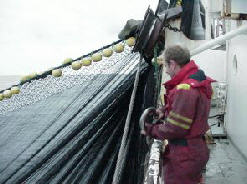|
In a new report to the European Commission, scientists from ICES are proposing measures for reducing the number of small cetaceans - dolphins and porpoises - that are accidentally caught in fishing nets. The proposals include making acoustic alarms on nets – so-called pingers — compulsory on certain fisheries, increasing the number of observers on fishing boats and reducing overall fishing effort.
The two main types of fishing that are causing a bycatch problem, claims ICES, are bottom-set gillnets, which mainly catch harbour porpoises, and pelagic trawls which operate in the upper waters of the sea and mainly catch common and striped dolphins.
The report was produced in response to a request by the European Commission for advice on ways of reducing the small cetacean bycatch problem. ICES is the main provider of scientific advice to the European Commission on fisheries and environment issues in the North East Atlantic.
David Griffith, General Secretary of ICES, said: “We know that despite fishers’ best efforts to avoid catching small cetaceans there is a bycatch problem in some fisheries. Pingers have been shown to reduce the bycatch of porpoises in bottom-set gillnets so we have recommended that they should be compulsory in certain bycatch “hotspot” areas.”
These hotspot areas, as set down by ICES, are:
|
